Upper and Circumferential Torsoplasty (Reconstructive surgery Surgery) After Major Weight Loss in Newcastle, Maitland & Hunter Valley, Australia
Book Online Now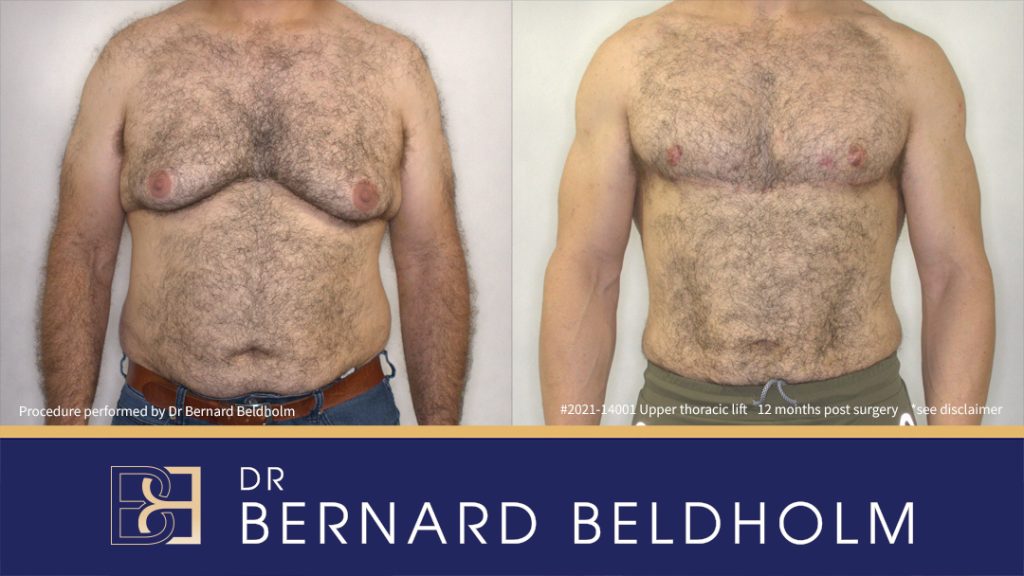
Disclaimer: Operation performed by Dr Bernard Beldholm. Adult content, surgery has risks; individual results vary, seek 2nd opinion. Please see the full disclaimer.
Upper and Circumferential Torsoplasty surgery in men is a highly effective procedure designed to remove excess skin and fat from areas such as the arms, chest, back, and abdomen. This procedure is especially beneficial for individuals who have undergone significant weight loss and are left with loose, excess skin that can cause discomfort and limit mobility. Dr. Bernard Beldholm, a specialist surgeon that focuses on post-weight loss body contouring, offers upper body lift (Torsoplasty) surgery as part of his comprehensive approach to body contouring in men.
Book Online NowFor men, Upper and Circumferential Torsoplasty differ significantly from the approach taken for women. In women, the procedure often includes mastopexy (breast lifts), breast augmentations (augmentation mammoplasty), and bra lipectomies. However, in men, the removal of loose skin in the anterior chest is more complex and typically involves the excision of breast tissue along with nipple grafting to create a more masculine chest. Additionally, the back area can also be treated with a circumferential upper torsoplasty, which removes excess skin and fat across the chest, back, and flanks for a complete body result.
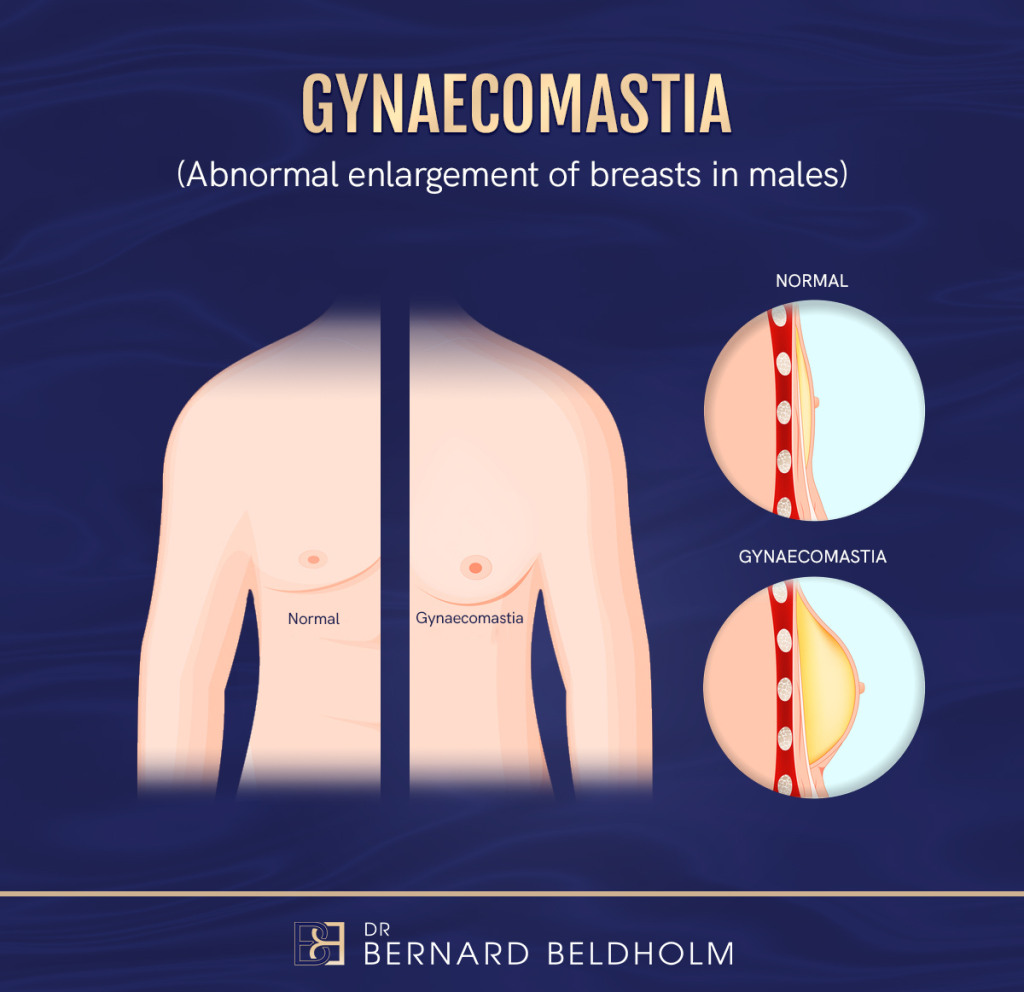
In males who have lost significant weight, there is also a notable overlap with gynaecomastia (male breast tissue development). Many men who gain a significant amount of weight develop pseudo-gynaecomastia, a condition where excess fat accumulates in the chest area, making it look like gynaecomastia. After losing weight, this excess tissue often results in a female-looking chest that can cause discomfort and embarrassment. Moreover, weight gain itself can lead to actual breast tissue development. Therefore, the management of the male chest post-weight loss shares considerable overlap with the management of male gynaecomastia, requiring a careful, tailored approach to removing both excess skin and tissue.
Key Takeaways
- Upper and Circumferential Torsoplasty effectively eliminates both abnormal breast tissue and excess adipose tissue (fat) while tightening any remaining loose skin to create a more masculine-looking chest.
- Ideal candidates for the surgery should have a stable weight, be in good overall health, and have realistic expectations about the outcomes and recovery process. Dr. Beldholm emphasises personalised care and thorough consultations to assess each patient’s unique needs.
- For men, the procedure differs from women, particularly in the chest area. The surgery for men may involve breast tissue removal and nipple grafting to create a more masculine chest.
- Gynaecomastia overlap: The post-weight loss chest contouring in men shares significant overlap with gynaecomastia management. After significant weight loss, men may experience both excess skin and retained breast tissue, which requires a combined approach of tissue removal and nipple repositioning.
- Upper and Circumferential Torsoplasty is an option for men who need comprehensive treatment across the chest, back, and flanks.
- The procedure is customisable, with components such as chest tissue removal, brachioplasty, gynaecomastia, circumferential torsoplasty, and suction-assisted lipectomy with VASER technology to remove stubborn fat. Dr. Beldholm tailors each procedure to meet the specific aesthetic and functional goals of the patient.
- The operation is performed at Maitland Private Hospital and typically requires an overnight stay.
What Post-Weight Loss Male Patients Should Consider an Upper and Circumferential Torsoplasty?
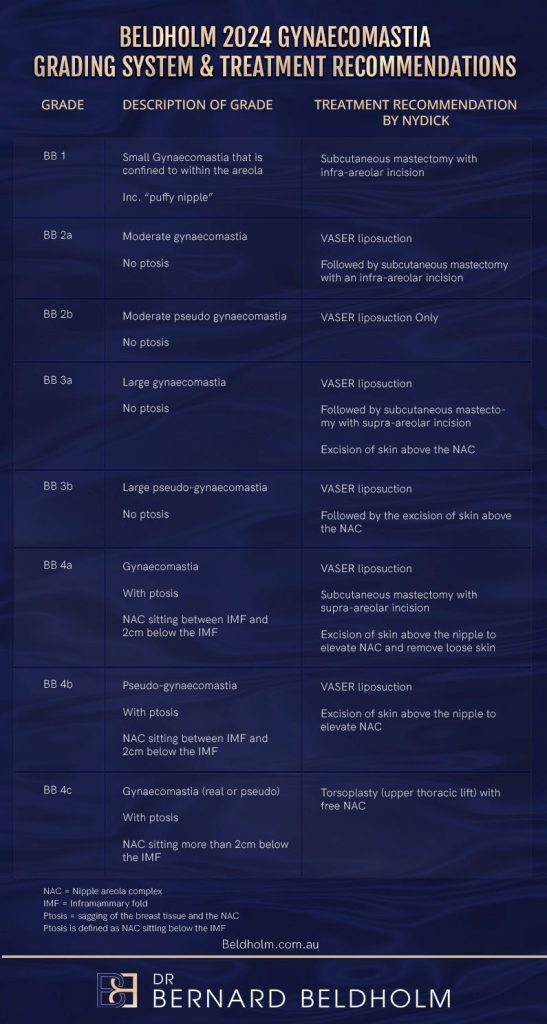
The approach to the male chest in post-weight loss body contouring is unique and tailored to focus on specific concerns. The primary goal is to eliminate both abnormal breast tissue and excess adipose tissue (fat) while tightening any remaining loose skin to create a more masculine-looking chest. Unlike women, where breast lifts (Mastopexy) or reductions (reduction mammoplasty) may be the focus, men undergoing body contouring after weight loss typically need a more comprehensive treatment.
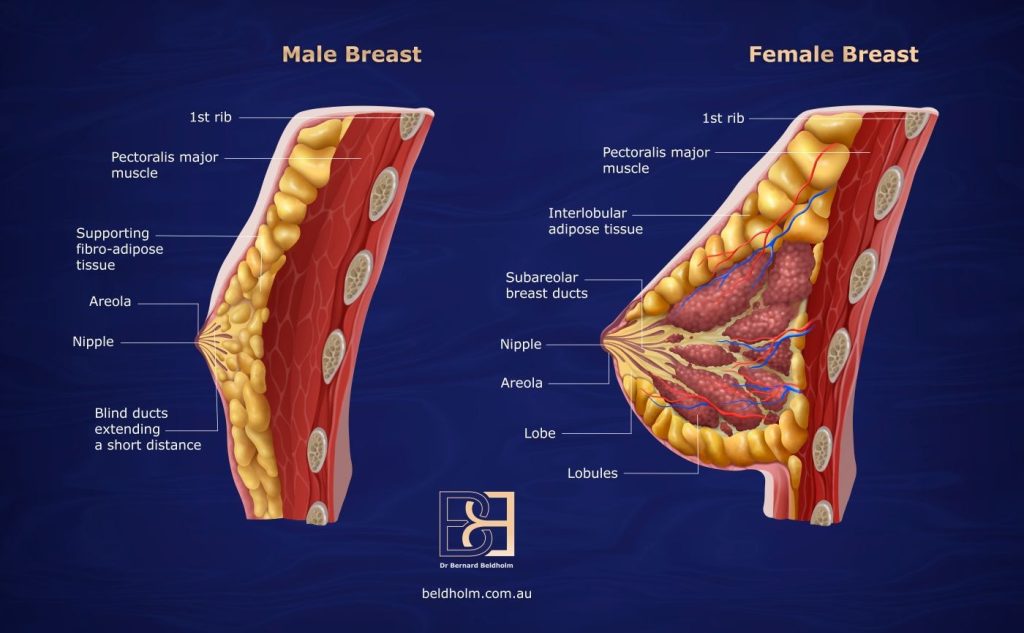
In men, the chest often undergoes changes post-weight loss, including gynaecomastia (male breast tissue development) or pseudo-gynaecomastia (excessive fat in the chest area that mimics the appearance of female breasts). Gynaecomastia refers to true male breast tissue development, which can remain even after weight loss. In contrast, pseudo-gynaecomastia occurs when a man has a chest that looks female but is made up mainly of adipose (fat) tissue, not actual breast tissue.
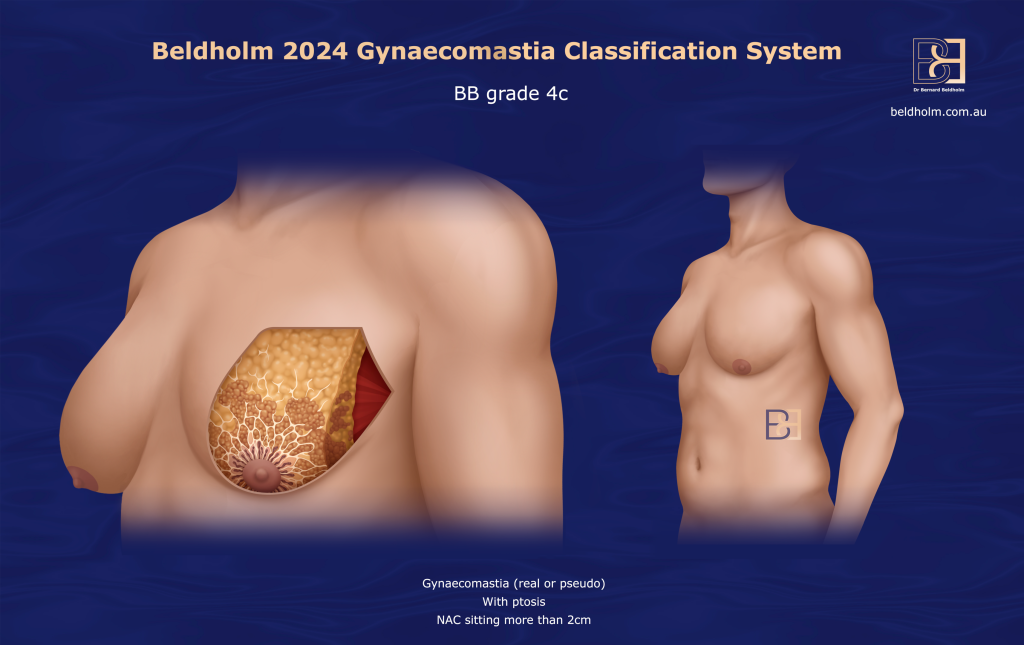
Dr. Bernard Beldholm has created a classification system for gynaecomastia, which helps in selecting the most appropriate treatment based on the severity of the condition. One specific category, Grade BB 4c, describes a male chest with significant ptosis, which is particularly common after large weight loss. For men in this category, Upper and Circumferential Torsoplasty is often the main indication. This procedure involves removing excess skin, fat, and, if necessary, breast tissue, while also repositioning the nipple to achieve a masculine chest contour.
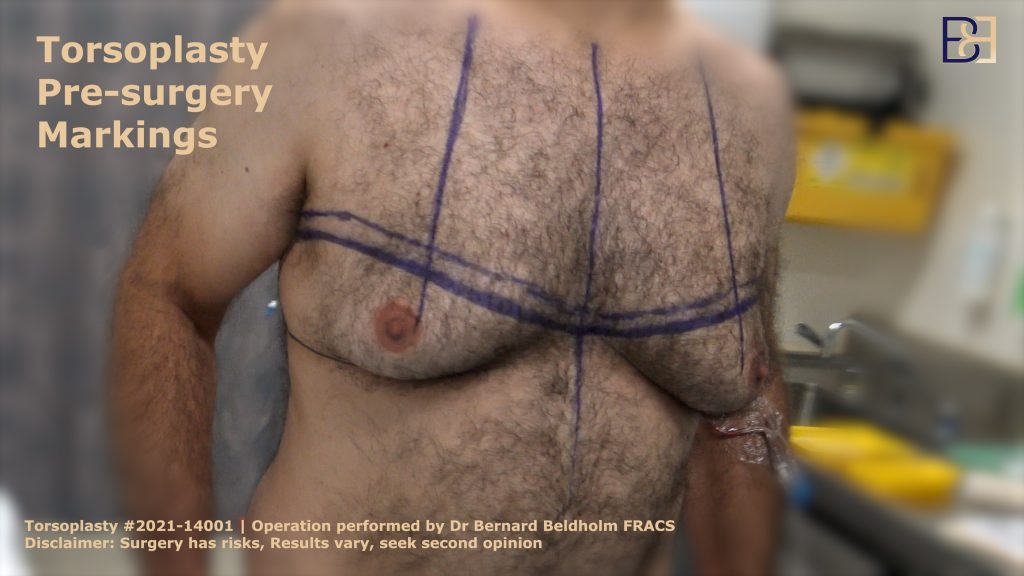
Understanding Upper and Circumferential Torsoplasty Surgery for Men After Significant Weight Loss
When considering upper torsoplasty in men, there are several important factors to keep in mind. This surgery is designed to treat the unique challenges that men face after significant weight loss, particularly when it comes to the chest and upper body contour. One of the key aspects of upper torsoplasty is treating the anterior chest, which often requires a similar approach to that used in the management of gynaecomastia (male breast tissue development). In post-weight loss patients.
Book Online NowFor many men, pseudo-gynecomastia (excess fat in the chest) may also be present. Post-weight loss, this fat often leads to a female-like chest appearance, causing discomfort. The goal is to excise both the breast tissue (if needed) and excess skin, repositioning the nipple to achieve a masculine-looking chest.
In addition to the chest area, the back and sides can also be treated as part of a circumferential torsoplasty. This comprehensive procedure not only lifts and tightens the chest but also reshapes the back and flanks. The patient is typically turned during surgery to allow the surgeon to focus on these areas from both the front and the back, creating a smooth, cohesive result.
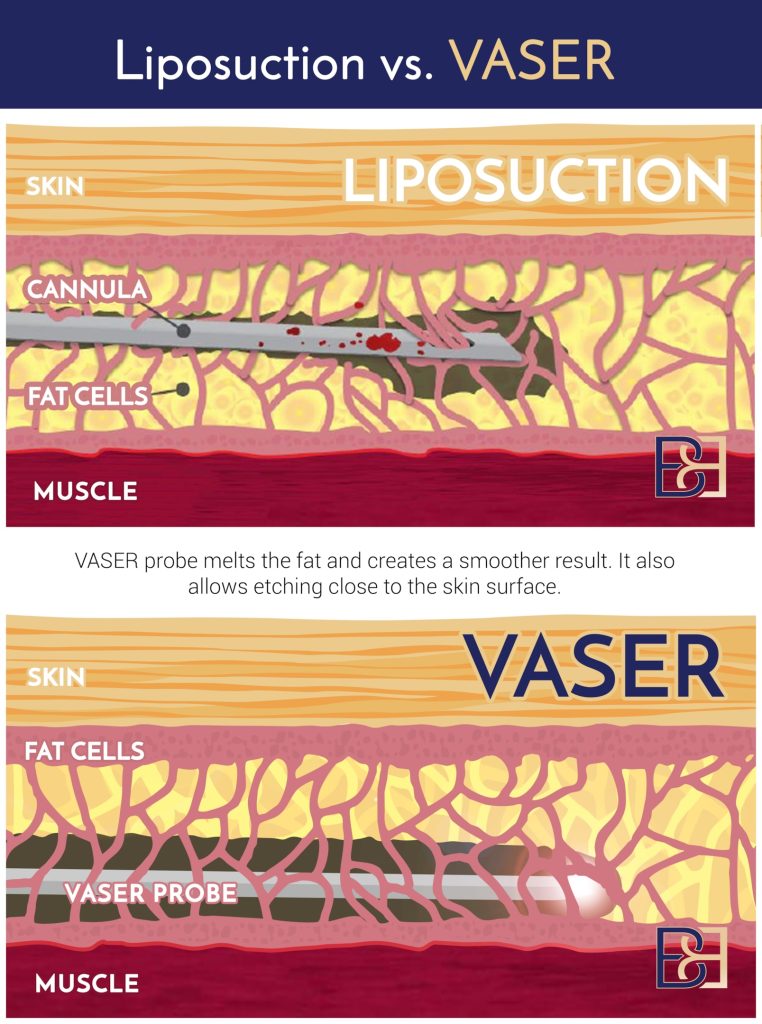
Although many post-weight loss patients achieve their ideal BMI and maintain a stable weight, some may still have excess fat deposits that don’t respond to diet or exercise. In these cases, suction-assisted lipectomy with VASER technology may be an essential component of the surgery. This allows for the removal of fat in areas such as the chest, back, or abdomen. Dr. Beldholm prefers using suction-assisted lipectomy with VASER technology, a technique that utilises ultrasound energy to gently remove fat while minimising damage to surrounding tissues, resulting in smoother and more defined contours.
Key Components of Upper and Circumferential Torsoplasty Surgery for Men
Upper body lift (Upper torsoplasty) surgery is highly customisable to meet the specific needs of men who have lost significant weight. The main components often include:
- Chest (Gynaecomastia Treatment): Excision of excess skin, adipose tissue, and sometimes breast tissue, with repositioning of the nipple to create a masculine chest.
- Arm Lift (Brachioplasty): Removal of excess skin from the upper arms, tightening the area around the muscle to create a more defined appearance.
- Torsoplasty: Removes excess skin and fat from the upper back.
- Suction-assisted lipectomy with VASER technology: Suction-assisted lipectomy with VASER technology is commonly added to target stubborn fat deposits in the chest, back, abdomen, or flanks.
The Surgical Procedure
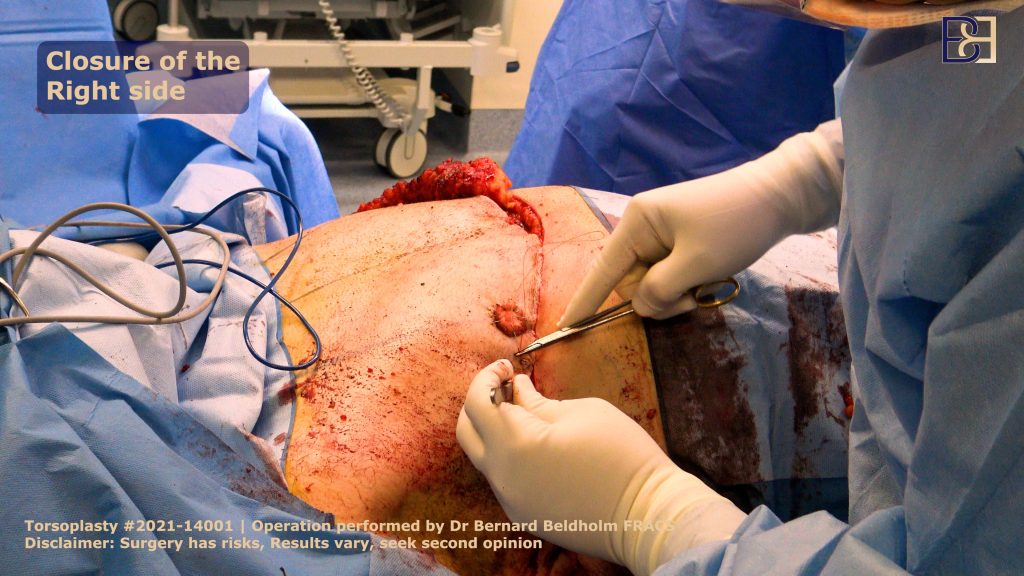
Upper body lift surgery requires general anaesthesia and typically involves a hospital stay of one to two nights. Incisions are made along the chest and back, extending from the sides of the chest to the midline at the back, which allows for the comprehensive removal of excess skin and tissue. The surgery usually lasts between three to six hours, depending on the complexity and number of procedures performed. The patient is generally turned during the surgery for easier access to both the front and back of the upper body.
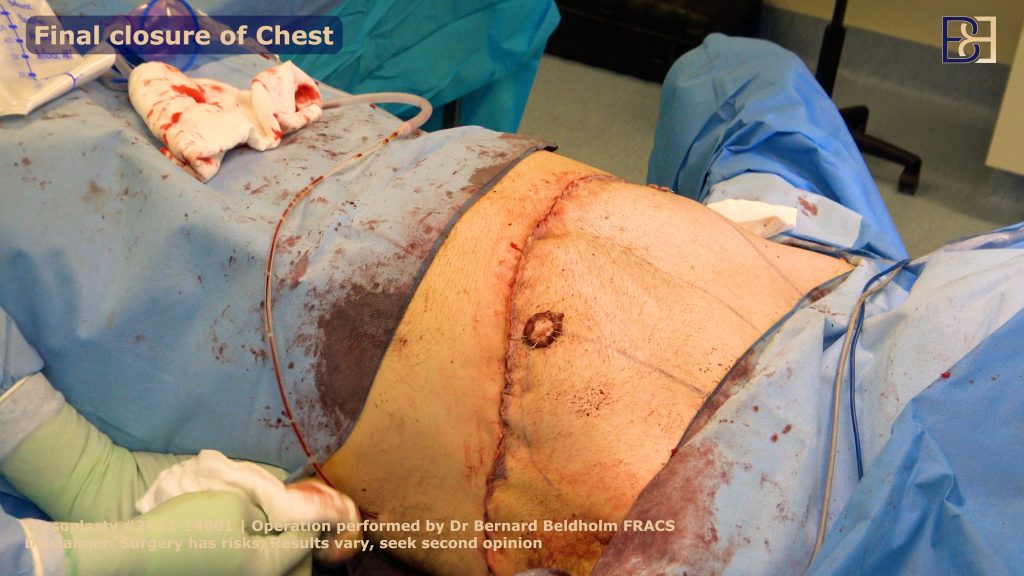
During the procedure, brachioplasty and gynaecomastia are often integrated. For many patients, this may be the ideal time to include suction-assisted lipectomy with VASER technology, particularly if there are stubborn fat deposits in the chest, abdomen, or back.
Recovery and Healing Process After Upper and Circumferential Torsoplasty Surgery with Dr. Bernard Beldholm
The recovery process following upper torsoplasty surgery is carefully managed by Dr. Bernard Beldholm to ensure optimal healing and the best possible results. Here’s an outline of the recovery routine under his expert care:
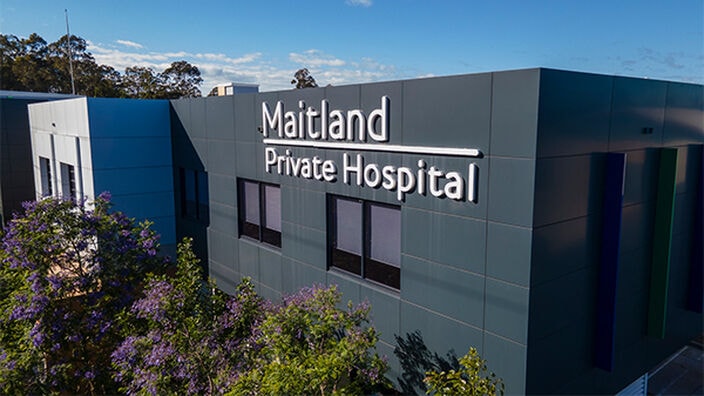
In-Hospital Care
Patients typically stay in the hospital for one to two days following the surgery. During this time, Dr. Beldholm and his team closely monitor the patient’s recovery, providing pain medication and antibiotics to manage discomfort and prevent infection. Drains are placed to manage fluid buildup and are typically removed during a follow-up visit one or two days later.
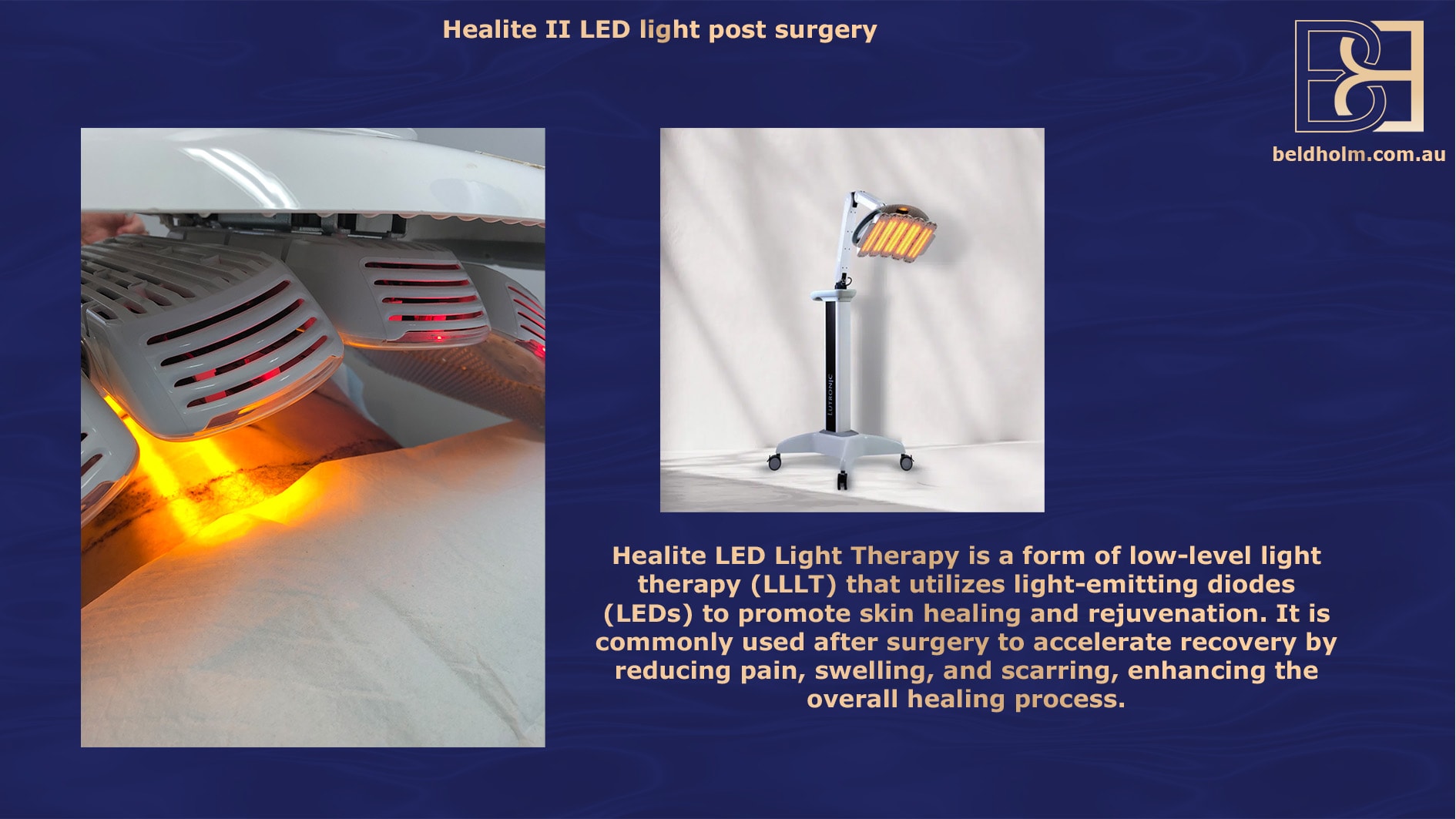
The First Two Weeks: An Intense Recovery Period
The first two weeks are critical for the healing process. Dr. Beldholm uses specialised dressings and devices to optimise recovery:
- Healite Therapy: Dr Beldholm uses Healite, a therapeutic light device, to accelerate healing and reduce inflammation during the early stages of recovery.
- PICO Dressings: These are applied to support the healing of incisions and reduce swelling. They are removed on day 7 following surgery.
- Nipple-Areolar Complex (NAC) Grafts: A pressure dressing is applied with clips to support the NAC grafts and maintain their position. This pressure dressing is typically removed on day 10.
Upper and Circumferential Torsoplasty Close Monitoring and Follow-Up
The first two weeks are crucial, and patients are seen frequently during this period. Follow-up visits with Dr. Beldholm and his dedicated nurse are scheduled to ensure everything is healing as expected. During this time, patients should have the opportunity to communicate directly with Dr Beldholm’s office, and any questions can be answered promptly.
For patients travelling from outside the area, it’s essential to remain near the surgical centre for at least 10 days to ensure proper care and allow for the NAC grafts to be managed. Ideally, patients should stay for two weeks. Dr Beldholm works closely with local GPs for travelling patients, and Zoom consultations can be arranged to ensure continuous monitoring and support.
Ongoing Follow-Up
After the initial two weeks, the routine follow-up schedule is as follows:
- 1 month
- 3 months
- 6 months
- 12 months
These follow-up appointments ensure that Dr. Beldholm can assess the healing process and make sure that the patient is on track to achieve the best possible outcome.
Important Considerations
During the first month, patients are required to wear a compression garment continuously to support healing and reduce swelling. Dr. Beldholm carefully monitors patients during follow-ups to ensure there are no complications and that the recovery is progressing well.
Patients are also advised to avoid strenuous physical activity and heavy lifting for at least 8 weeks to ensure proper healing and to avoid any complications, such as delayed wound healing or seroma formation.
By following Dr. Beldholm’s comprehensive recovery routine and attending scheduled follow-up appointments, patients can ensure a smooth recovery and optimal surgical outcomes.
Potential Risks and Complications of Upper and Circumferential Torsoplasty
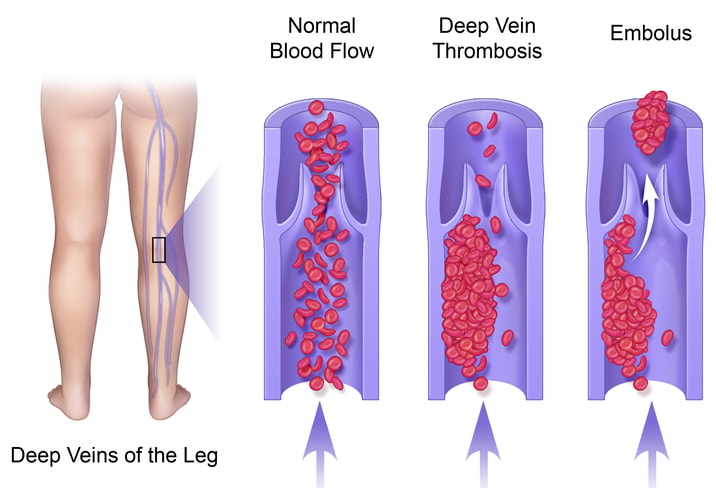
Upper and Circumferential Torsoplasty surgery, like any surgical procedure, carries potential risks and complications that may arise during or after surgery. These can include infection, scarring, blood clots, wound healing issues, and seroma formation (accumulation of fluid under the skin). Patients should monitor their bodies for signs of complications and seek medical advice if any concerns arise.
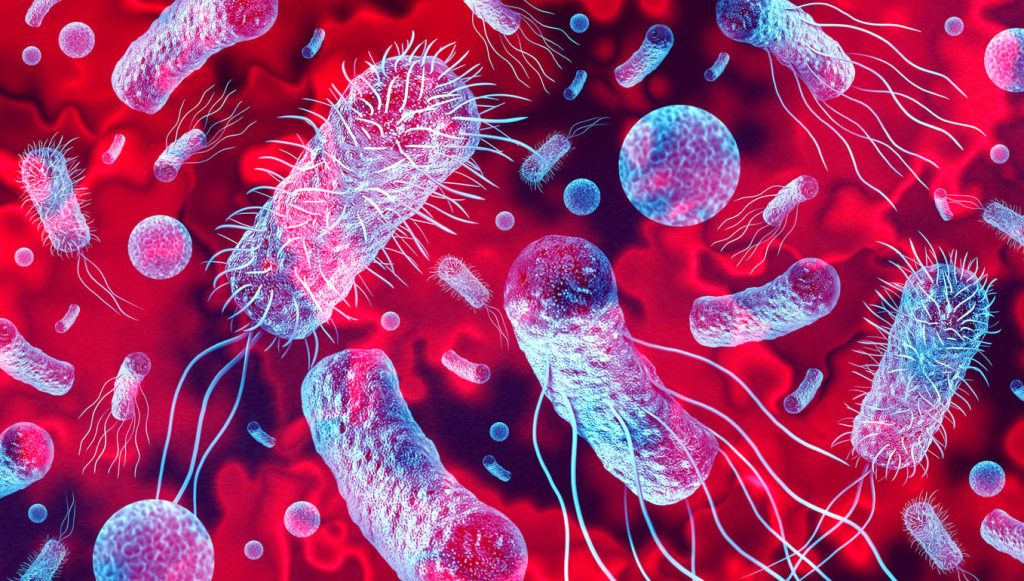
Slow walking around the house can help prevent blood clots, and following post-operative care instructions from the surgeon can significantly reduce recovery risks.
Scarring is a common outcome after Upper and Circumferential Torsoplasty surgery, and patients should be prepared for visible scars, which are strategically placed to minimise visibility and blend into body contours. Over time, the scars may fade, but it’s important to note that they will never fully disappear. The process of scar healing can take up to one to two years, and while the scars will soften and fade, they will remain as part of the surgical result.
To promote optimal healing and minimise the risk of complications, it’s crucial to avoid certain lifestyle factors, particularly smoking, as it can significantly impair the body’s ability to heal. Smoking reduces blood flow, delays wound healing and increases the risk of infection and scarring. Dr Beldholm strongly recommends that patients refrain from smoking both before and after surgery.
By following Dr. Beldholm’s post-operative care instructions, including managing lifestyle factors like smoking, patients can support their recovery, reduce the appearance of scars, and achieve the most successful outcome from their upper torsoplasty surgery.
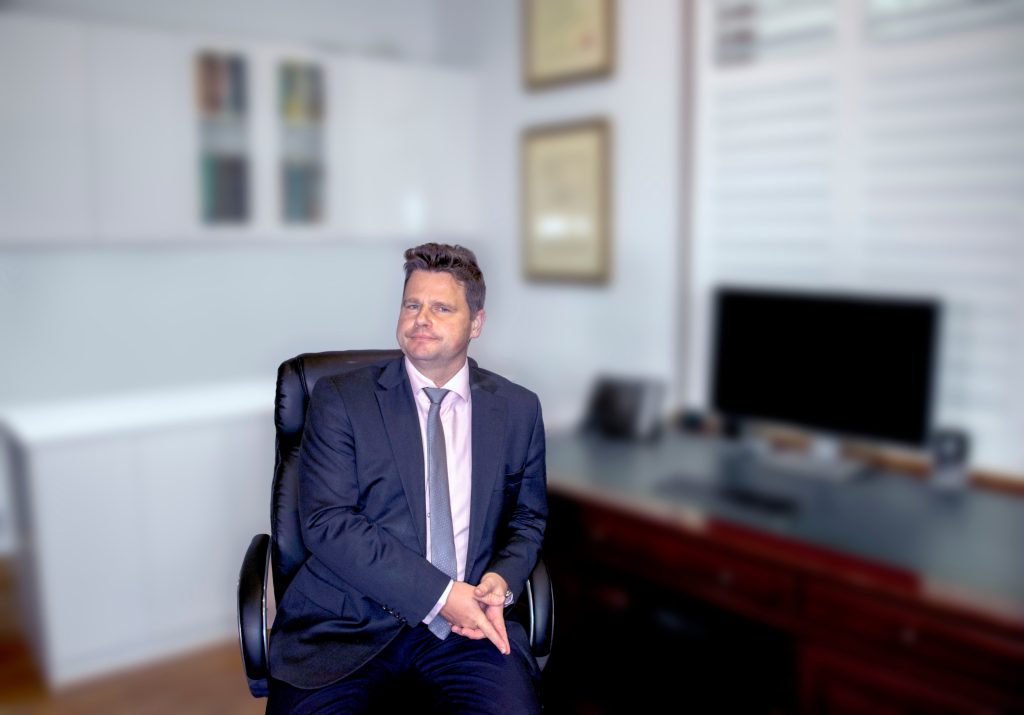
Dr. Beldholm’s Final Thoughts on Upper and Circumferential Torsoplasty Surgery
Upper and Circumferential Torsoplasty surgery is a highly rewarding procedure for individuals who have undergone significant weight loss and are struggling with the physical and emotional impact of excess skin.
Upper and Circumferential Torsoplasty in Male Patients: Clinical Considerations
For male patients, Upper and Circumferential Torsoplasty in Male Patients can be considered as part of a surgical plan to manage redundant skin and adipose tissue in the upper torso, particularly following significant weight loss. This procedure may also include management of conditions such as gynaecomastia or pseudo-gynaecomastia, which require careful clinical assessment. A classification system for gynaecomastia can assist in guiding treatment selection based on the degree and nature of tissue involvement.
An Upper and Circumferential Torsoplasty in Male Patients may be indicated in patients requiring removal of excess skin and tissue across the chest, back, and flanks. When appropriate, suction-assisted liposuction technologies—such as VASER (vibration amplification of sound energy at resonance)—may be utilised to support fat removal in conjunction with excisional techniques.
While this surgery may contribute to improved physical contour, the clinical indications often extend beyond appearance. Patients may present with functional concerns such as chronic skin irritation, hygiene difficulties, or discomfort related to excess skin folds. Surgical intervention in these cases aims to improve quality of life and physical function.
